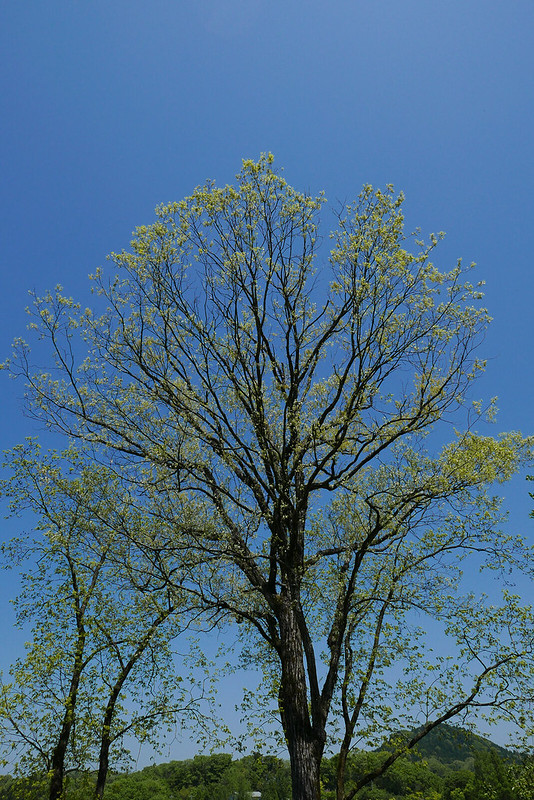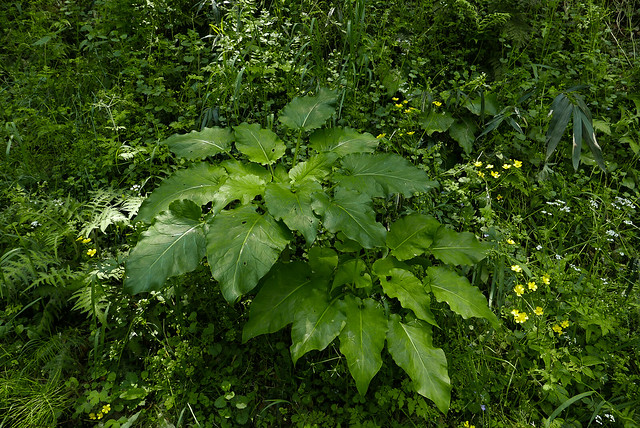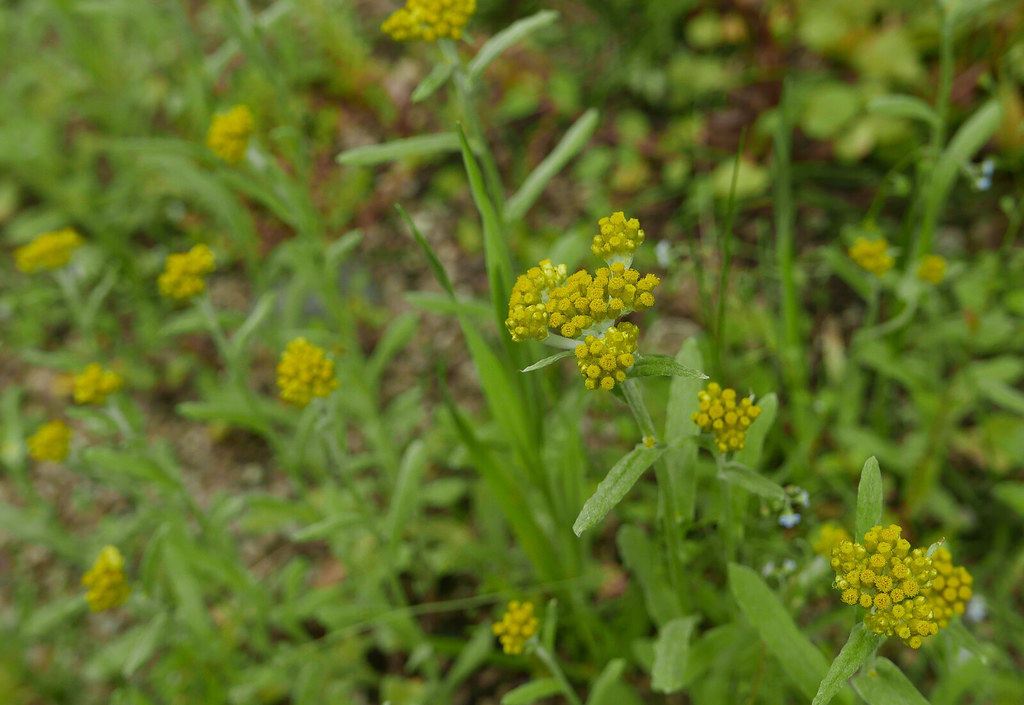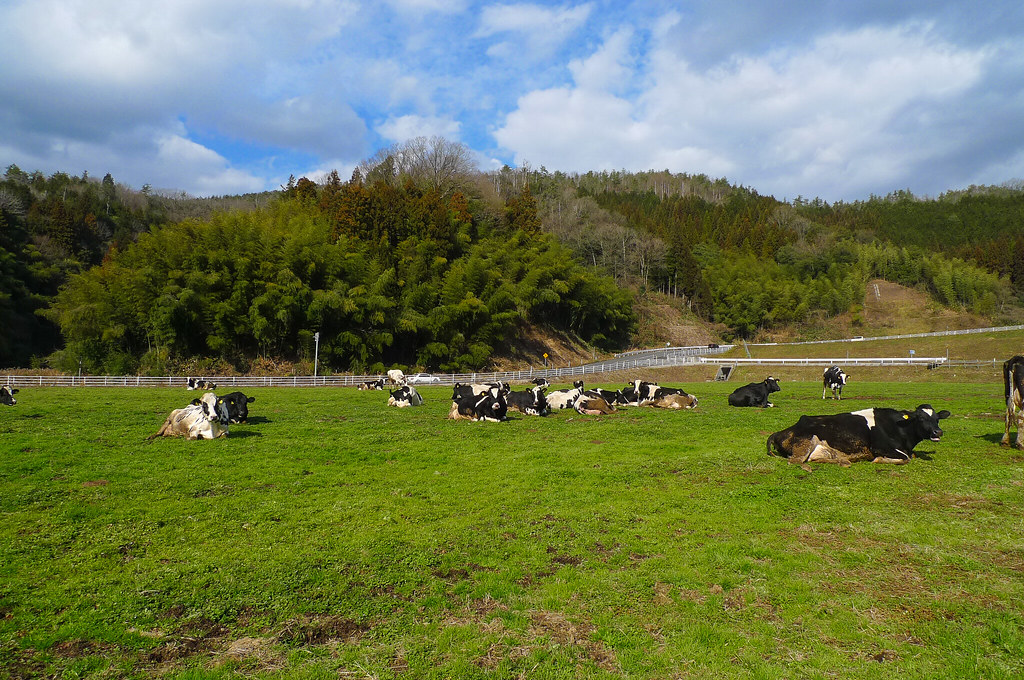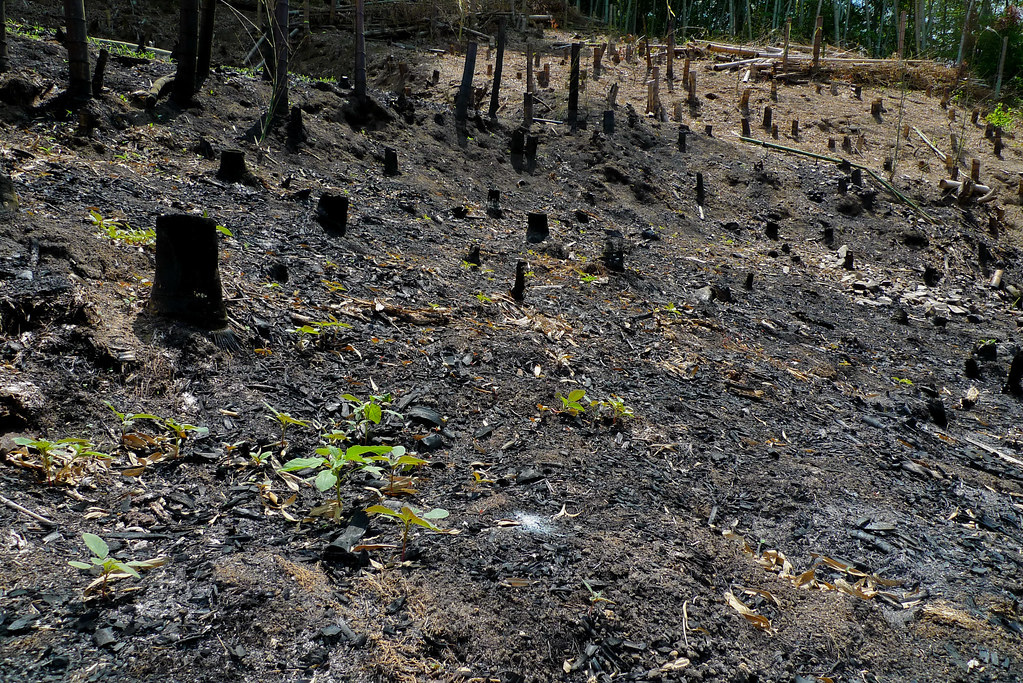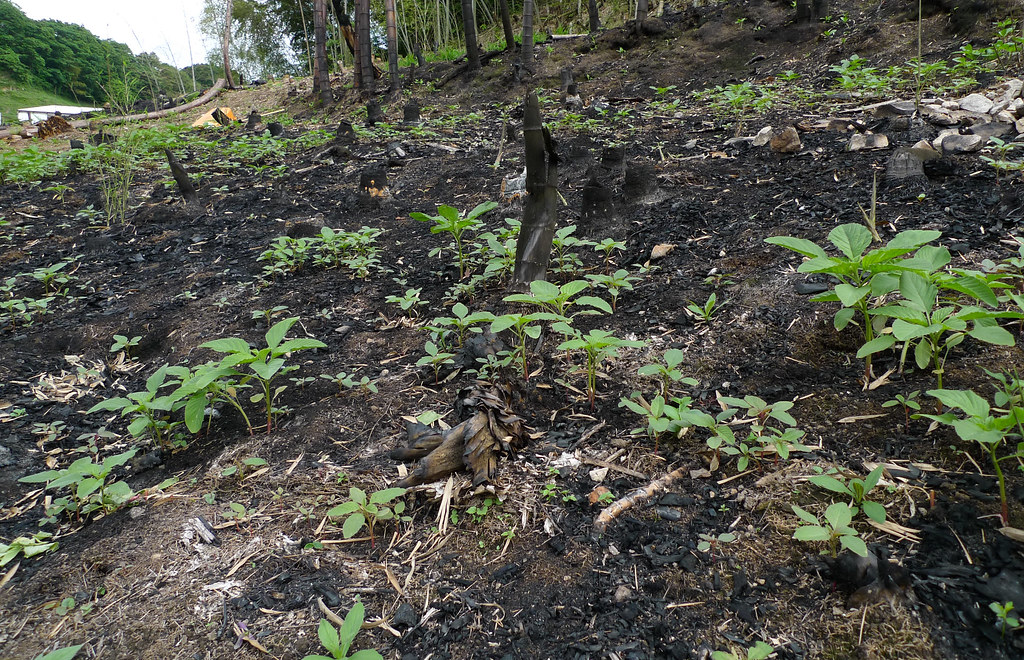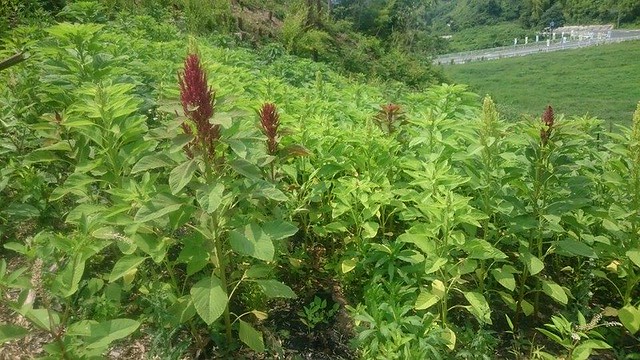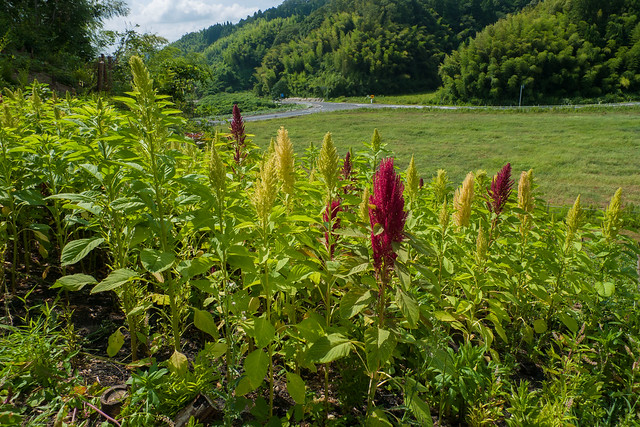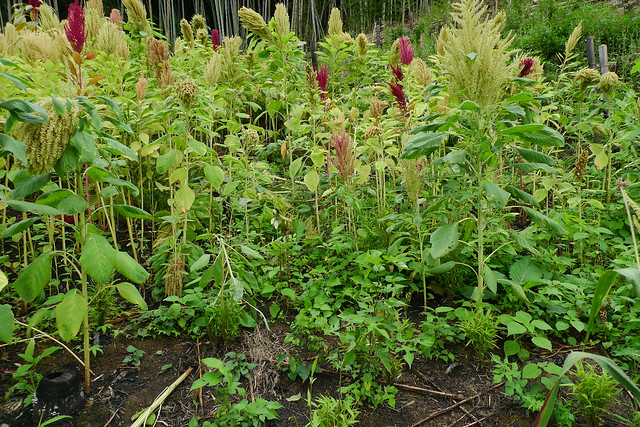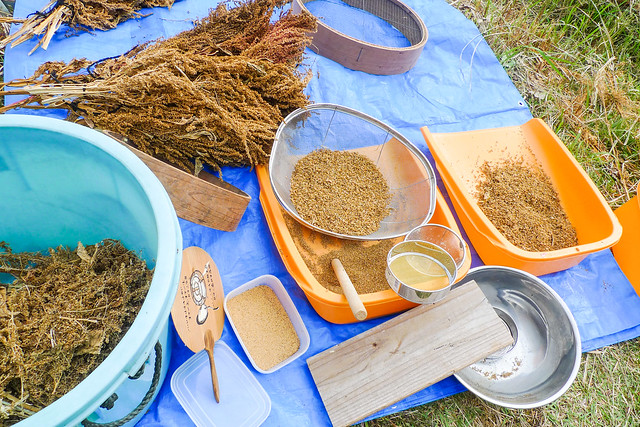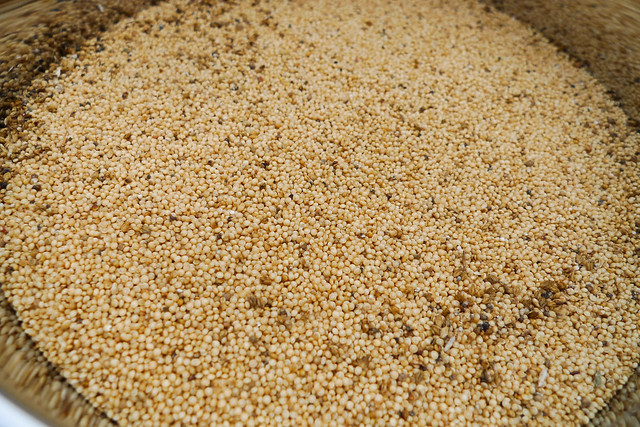春の調べー5月3日
萌えいづる山の若緑も、そろそろ落ち着いた色に変わっていこうかというこの頃のことを記すものである。
コナラの新緑はこれからなのだなあと知る。食の杜の茅葺きの家からワイナリーをのぞむ場所にたつ、ひときわ大きなコナラがこんなんだった。
ウバユリのある場所。去年よりも数が多い気がするのは気がするだけなのかもしれないが、目立つ。茎がたたないものがメスでたつものがオスだとクニ子ばあちゃんはいうが、茎が立たないものがあるのか。そろそろ何本かとってみようと思う。
ホウコ(ハハコグサ)をとって、ホウコモチつくったのは去年5月の2週目だったろうか。庭に見つけて「保全」してきた場所ではふえている、こちらはあきらかに。
畑の隅にある苧麻が背をのばしはじめた。道べにあるものはいずれ刈られるので、どこにあるかわからなくなるものだが、いまならわかる。あそこと、ここと、ひとつひとつ記録するには及ばねど、記憶にとどめて経年を確かめることができればと思う。
ほかにもいくつか。また記そう。
Izumo no Yamahari〜sec.3
It was a sunny day that unusual blue skies spread in the Sanin winter. The temperature at 10 o'clock is 8 degrees Celsius. On this day, I arranged the bamboo, repaired the fence, but it was so sweaty. There were five participants in the activity.
A calm spring day winter's day. I will be reminded that this is also winter.
Last year the slash-and-burn field in the spring, the fence of the land calling one field was destroyed, cows were coming in. It's about one. I guess he wanted to enter so much. I knew that the pile was loose, but as I saw only the winter grass, it was tough to break the cows. There were few footprints or feces, and the cows seemed to have pulled up quickly because there was nothing to eat, and there were a few brand new scratches. Stalk of sharks. There are some ruffled and trace marks. There are some varieties that take sugar in Takakibi, so it may be sweet.
After that, the barley was crushed a little bit, and there was one shit in the middle. It is said that 75% of human feces are microorganisms and plant fibers are about 17%, but what about cattle? I thought of such a thing.
The young bud of wheat and barley that is most lush in the stepping field. I think this is good, but it is strange that I do not say anything at all. It is the play bamboo that you can see the marks you ate in the surroundings. Although I do not eat bamboo, I think that this is also reminding me. Ah yes it may be. It may be that you want to eat stems that are solid in winter. Let's keep it in memory. However, as for the hypothetical part of "Okami" as moderately.
I'm not sure if the temperature is 8 degrees Celsius is comfortable for cattle, but it's certainly lying down in the sun. If there is a little more day on the slope, there will be some individuals moving there.
If you would like to participate in the activities please see the link below.
Wanted Volunteers to Preserve Satoyama in Okuizumo,Japan
A volunteer participant is recruiting through the menu below.
It is mainly outdoor activities. Beginners, veteran, age and young and old, …anyone welcome! No problem! Because people are not enough!
Please send a mail by form→
(http://s-orochi.org/public/archives/520)
1. Preservation of devastating bamboo groves …… It is logging, transporting and bamboo. Various for reborn into a pleasant bamboo forest.
2. Preparation of slash and barn(as traditional agricultural practices).
3. Preparation for turnip seeds …… In order to leave a nice turnip seed, we also grab and eat ”nabana” flowers and care for it.
4. Making tools for bamboo papers, fiber drying, prototyping, etc.
5. Sorting of millets and trial production of dishes.
6. As preparation for the event in late April, preparation for making bamboo papers that can be experienced by parents and children or preparing bamboo cups.
7. Survey of listening to the elderly as a regional food culture survey.
Rough notes on slash and burn in Srilanka
It is notes on a slash-and-burn of Sri Lanka ...... As I mentioned at the very end, I think that the slash-and-burn field of Sri Lanka is parallel to and linked with paddy field cultivation and agroforestry, and has a great suggestion for what we are going to do in Okuzumo,Japan It was. Yes. Either way I would like to summarize a little more, but before memories get diminished, I will memorize it in a while.
-----------------------------------
It is said that Sri Lanka is in a sharp population increase phase, and the slash-and-burn agricultural practice called Chena in Sri Lanka has become unsustainable due to shortening of fallow season. There are places where soil erosion has occurred in some places where conversion to farmers' field instead of the trees starts, and there are places where soil erosion is occurring, some of which are attributed to slash-and-burn farming. Sinhala? Although the slash-and-burn field called Chena in Chena also heard that there is a place remaining in the eastern region where the influence of the civil war was great, in most areas it has been banned from the 1970s to the 1980s.
Interestingly, Chena planted grains in the middle by mixing, vegetables on the periphery, how to build a fence with burned branches and vines to circumvent wildlife on the outside.
And that Chena's main cereal was Finger millet (local name is Kurakkan). Although the use of Shikoku beer has declined sharply, it is still in the market · cafeteria (I was interested in trying to eat, I am interested in what form is being served, it seems that I used to make it dango in old days). What is important as a health food.
◆ Not only forests, there are different Chena depending on the vegetation, such as rainforests, meadows, etc. Each name is different. It seems that there are some which are mainly classified into 4, some of which create a reservoir.
◆ Chena is merely one of many land use, basically thousands of years of irrigation paddy field cultivation, (currently) home garden called agroforestry ranging from 5 ridges to 2 towns, and Chena. It has sustainability even in the plantation era under British rule, but it has come to have big and complicated problems in the course of postwar agricultural modernization .
◆ In conjunction with home gardens, we are trying to hedge biodiversity and risk by taking the mosaic of vegetation. Besides animals, birds and insects (including bees), bats, and other birds' useful consciousness are quite high. Is the name such as "a tree that eats a bird"?
◆ It should also be noted that Chena's role is not limited to food supply, as it coexists with paddy field cultivation and home garden.
For example, it is conscious as a buffer zone of animal damage.
This point of view is hard to be noticed, but it is extremely important as our aim.
高取正男・橋本峰雄,1968『宗教以前』
なんども読み返しながら、いまだにつかめないでいる。読み終えることができないともいう。たとえば、ここに、まえがきの冒頭を抜き書きしてみよう。
宗教は体験であって、たんに倫理からの要請ではない。信仰は主観的な信念に過ぎぬものではなく、客観的実在つまり絶対者とか超越者とかからの呼びかけによって成立する。しかし、たとえそのようなこの世の外の神や仏の声に答えるという形の信仰ではなくても、この世界と人生とをひとまとめにして、それに決定的全体的な態度をとらねばならぬとき、やはり人はある宗教的信仰の体験を持つのであろう。宗教はつねに人間存在の本質的なモメントである。
こうした表明を序文におけるような著者はいま、2010年代の言論界にはいない。あり得ない、時代錯誤である、もはや過去の遺物である……と言いたいのではない。むしろ、こう言うことができた時代(1960年代)の、少なくとも宗教を語る土台・前提・知の厚みをまぶしく感じる。
この書は、宗教以前という題にのっとって、民俗学が探求してきた、「忌み」「産土神」「先祖祭り」「墓制」という軸をたどることで、宗教と国家、宗教と科学を問おうとしている。
語る前提の「体験」たる、民俗文化が、まだその痕跡を、¥生きた形でとどめていた時代なのだ、昭和40年代は。そして、私が生まれた時代でもあり、平成生まれの大学生にとっては、どうにも想像が及ばぬところが多大であろう。
《宗教はつねに人間存在の本質的なモメントである》……この言葉が、若い学徒に通じるような道を、私は架橋したいと思う。つまづきながら、何度でも読み返しながら。
